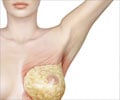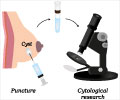
Mammographic density mediates the protective effect of early-life body size on breast cancer risk
Go to source). The study, published in Nature Communications, explored the unexplained protective effect of higher body size in childhood on breast cancer risk using Mendelian randomization, to examine the connections between body size in childhood and adulthood, puberty onset timing, breast tissue density, and breast cancer risk.
‘Increased body size during childhood, particularly around the onset of #puberty, correlates with reduced #breasttissue density. Dense breast tissue, comprising glandular and fibrous tissue, is typically where #breastcancer originates. ’
Tweet it Now
Link Between Childhood Adiposity and Breast Tissue Density
The research team looked in more detail at one of the most plausible connections - breast tissue density. Higher breast density, measured with a mammogram, is an established risk factor for breast cancer, and is known to be affected by body size. When a mammogram shows dense breast tissue, it means there’s a higher proportion of glandular or fibrous tissue compared to fatty tissue. Conversely, when breast tissue is less dense, there’s more fatty tissue relative to glandular or fibrous tissue.There is growing evidence that adiposity in childhood can lead to various adult diseases. However, in the case of breast cancer risk, observational epidemiological studies, and more recently studies that used genetic data, have shown that higher body size in childhood decreases the risk of developing this disease.
The researchers used data from genome-wide association studies (GWAS) and Mendelian Randomization analysis. They were able to demonstrate that over 50 per cent of the protective effect that higher childhood body size has on breast cancer risk is explained by the changes in dense breast tissue.
Having less dense area in the breast subsequently leads to a reduced breast cancer risk in adulthood. This is the proposed mechanism by which higher childhood body size decreases breast cancer risk. However, the biological mechanism/pathway is more complex than this, and identifying smaller steps in this process using genetic data is a part of uncovering the basis of this unexplained causal relationship.
Dr Marina Vabistsevits from the University of Bristol’s MRC Integrative Epidemiology Unit (MRC IEU) and Bristol Medical School: Population Health Sciences (PHS), and corresponding authors, said: “Studying the mechanism of childhood adiposity protective effect is important, as weight gain in childhood cannot be considered to be a preventative measure for breast cancer.
Advertisement
Reference:
- Mammographic density mediates the protective effect of early-life body size on breast cancer risk - (https://www.nature.com/articles/s41467-024-48105-7)
Source-Eurekalert















